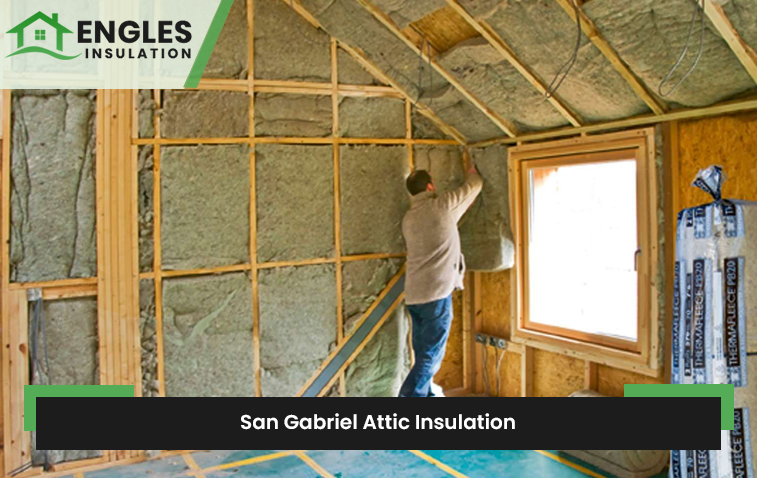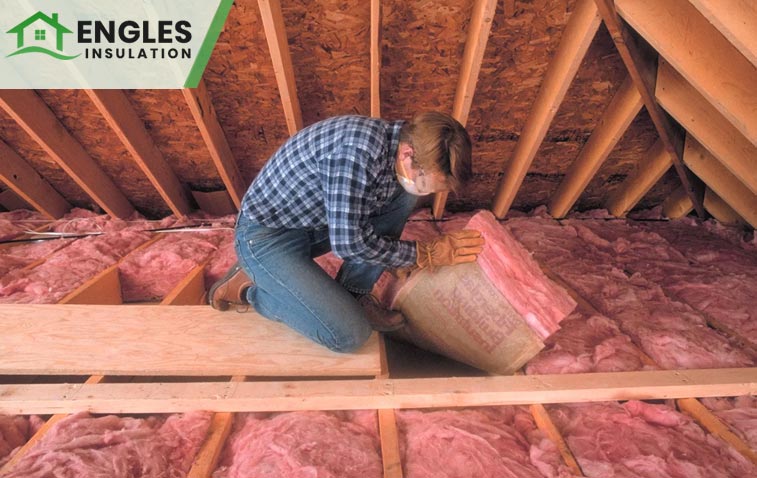Exploring Different Types of Attic Insulation Materials
Considering insulating your attic, you must understand the different insulation materials available. Each type has unique properties and benefits, so choosing the right one for your home is crucial.
Explore different types of San Gabriel attic insulation materials and their costs: fiberglass insulation is a cost-effective choice. The eco-friendly cellulose insulation averages $1.5-$2.5/sq ft. Although pricier at $1.5-$3.0/sq ft, spray foam offers superior thermal resistance. Reflective insulation, ideal for warmer climates, ranges from $0.15-$0.50/sq ft. Make an informed decision today!
This article will discuss four popular types of attic insulation: fiberglass, cellulose, spray foam, and reflective insulation. We will explore the pros and cons of each type, as well as their cost and installation processes.

Fiberglass Insulation
Fiberglass insulation, a common choice for San Gabriel attic insulation, is made of excellent glass fibers and is a cost-effective insulation option. It is known for its fire-resistant and non-combustible properties. Fiberglass insulation effectively minimizes heat transfer, thus maintaining a comfortable indoor temperature. It comes in two forms: batts (pre-cut panels) and rolls, making it a versatile solution for various attic spaces.
Fiberglass insulation is widely recognized for its affordability, making it a highly favored choice among homeowners seeking cost-effective solutions. The cost per square foot varies depending on the thickness and R-value you opt for, allowing you to tailor it to your needs. However, it’s crucial to consider the long-term benefits and energy savings that come with proper insulation.
A well-insulated attic, for example, can lead to significant annual savings, typically ranging from $1 to $2 per square foot. By investing in quality insulation, you not only create a comfortable living environment but also pave the way for substantial financial savings in the years to come.
| Pros of Fiberglass Insulation | Cons of Fiberglass Insulation |
| Cost-effective and affordable | Installation requires safety equipment to avoid irritation from glass fibers |
| It comes in versatile forms (batts and rolls) | It may not be as effective at reducing air leaks as other types of insulation |
| Fire-resistant and non-combustible | R-value can decrease over time if the material settles |
| This can result in long-term energy bill savings | Professional installation is highly recommended for best results |
Cellulose Insulation
Cellulose insulation, another popular San Gabriel attic insulation option, primarily comprises recycled paper products. It is known for being eco-friendly and offers excellent thermal and acoustic insulation properties. Regarding cost, cellulose insulation typically runs between $1.5 and $2.5 per square foot, depending on the thickness and R-value.
When evaluating the overall cost, it’s essential to consider the long-term energy savings associated with materials like fiberglass. While fiberglass may have a higher upfront cost, it can significantly save energy bills over an extended period. This is attributed to its superior insulation properties and ability to maintain optimal temperature levels, reducing energy consumption and costs in the long run.
So, when deciding, it’s crucial to weigh the initial investment against the potential long-term benefits that can result in substantial energy savings.
| Pros of Cellulose Insulation | Cons of Cellulose Insulation |
| Eco-friendly as it’s made from recycled paper products | It might require professional installation for optimal effectiveness |
| Excellent thermal and acoustic insulation properties | The upfront cost is higher than fiberglass insulation |
| Can offer substantial long-term energy savings | Can settle over time, resulting in a decrease in R-value |
| Fire-resistant when treated with fire retardants | May absorb moisture, risking mold growth in damp conditions |
Spray Foam Insulation
Spray foam insulation is a premium choice for San Gabriel attic insulation. It offers superior thermal resistance and air-sealing properties. Although its cost may seem high initially, between $1.50 and $3.00 per square foot, the potential energy savings are significant. It can fill in all the nooks and crannies in the attic, providing a comprehensive barrier against heat transfer and air leaks.
Despite the upfront cost, investing in energy-efficient solutions can bring substantial long-term savings, allowing you to recoup your initial investment quickly. By making the right choice for your home, you contribute to a sustainable future and ensure year-round comfort for you and your loved ones. Experience the benefits of enhanced energy efficiency and enjoy a cozy and environmentally friendly living space.
| Pros of Spray Foam Insulation | Cons of Spray Foam Insulation |
| Superior thermal resistance | Higher upfront cost |
| Excellent air-sealing properties | Requires professional installation |
| Can fill in all nooks and crannies, offering a comprehensive barrier | Potential for over-spray if not correctly installed |
| Significant energy savings that can quickly offset the initial investment | It may not be suitable for all types of attics |
| Fire-resistant when closed-cell spray foam is used | It can be difficult to remove if later renovation is needed |
At Engles Insulation, we provide high-quality insulation solutions tailored to your needs. Our experienced team works with various materials to expertly install attic insulation for maximum effectiveness.

Reflective Insulation
Reflective insulation, an innovative option for attic insulation, effectively blocks radiant heat, making it ideal for homes in warmer climates. This type of insulation uses reflective surfaces, usually aluminum foils, to repel heat and keep it from entering the attic space. It’s available in rolls and can be installed between rafters, floor joists, and wall studs.
One notable benefit of reflective insulation is its ability to effectively reduce cooling costs in your home during the hot summer. Minimizing heat transfer through the insulation helps maintain a cooler indoor environment, saving you money on energy bills. The cost of reflective insulation varies depending on factors such as the size of your home and the specific product chosen.
It typically costs $0.15 to $0.50 per square foot. While this insulation has an upfront cost, it should be considered a long-term investment in a more comfortable and energy-efficient home. With reflective insulation, you can enjoy a cooler living space while experiencing lower energy consumption and reduced environmental impact.
| Pros of Reflective Insulation | Cons of Reflective Insulation |
| Effectively blocks radiant heat, ideal for warmer climates | It may not provide sufficient insulation in colder climates |
| Can reduce cooling costs during summer months | Installation requires precise placement and sealing for optimum performance |
| It comes in versatile forms (rolls), which can be installed between rafters, floor joists, and wall studs | It can be more expensive than other types of insulation per square foot |
| Improves the overall comfort of your home by reducing heat entry | Not as effective at blocking conductive or convective heat |
Consider installing attic insulation if you want to improve your home’s energy efficiency and save money on utility bills. Luckily, you don’t have to look any further because our team at (877) 470-7898 specializes in attic insulation services in San Gabriel and the surrounding areas.
Conclusion
There are several options for San Gabriel attic insulation, each with pros and cons. The ideal insulation type for your home will depend on budget, climate, and personal preferences. Carefully considering these factors is crucial in making the right decision. Choose wisely for optimal insulation.
If you need help determining which type of insulation is best for your home, consult a professional insulation company like Engles Insulation. Our team can assess your needs and recommend the most suitable option for optimal results. Contact us today to learn more about our services and how we can help keep your attic comfortable and energy-efficient all year round.
